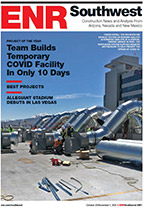The Florida Dept. of Transportation and concessionaire Miami Access Tunnel officially broke ground in late May on the $1-billion Port of Miami Tunnel project, designed to ease traffic congestion in downtown Miami.
“Everybody working on this project is very excited,” says Rick Wilson, chief operating officer and technical manager for Miami Access Tunnel (MAT), Miami, which will design, build, finance, operate and maintain the tunnels. A tunnel project in Florida is unique, he says. Design and construction are estimated at $607 million. The state will pay half the capital costs, with local governments picking up the balance.
Bouygues Civil Works Florida, a subsidiary of Bouygues Publics Travaux of France, will design and build the tunnel. Clearing and sitework on the four-year project began on May 24. During the first phase, crews will spend three months relocating an existing Watson Island frontage road so that MacArthur Causeway’s eastbound lanes can move south, opening the median for tunnel construction.
While completing the roadway work, the team will begin widening the MacArthur Causeway bridge from Miami to Watson Island.
The tunnels will connect Watson Island to Dodge Island, the location of the Port of Miami. Each of the two tunnels is roughly 4,250 ft long, including 42 ft of cut-and-cover work on each end. The project includes 349 ft of U-wall at the approach on Watson Island and 362 ft of U-wall on Dodge Island.
A tunnel-boring machine, now under design in Germany, will bore 120 ft under the so-called Government Cut, a body of water between the two islands. The depth allows for cruise-ship traffic while maintaining some rock and limestone formation above the 42-ft-dia tunnels.
“That gives us 30 ft of rock and soil between the bottom of the channel and the top of the tunnel, and we need that for reasons of holding the tunnel down,” Wilson says. “It has to be at that depth to get under the channel.”
The geology at the site includes a strata of loose sand and limestone.
“That presents its own set of challenges, since it is not the same rock all of the way through,” Wilson says. “We have to have a boring machine that can handle a variation in hardness.”
The original plans called for both tunnels to start at Watson Island and head toward Dodge Island. However, the team now is considering boring only one tunnel from Watson to Dodge; once there, the TBM would be disassembled, make a U-turn and head back to Watson Island.
In Germany, Herrenknecht will manufacture, assemble, test, disassemble and ship to Miami the tunnel-boring machine. Wilson estimates the TBM will be about 370 ft long when assembled.
Tunnel boring likely will begin next March and last an estimated 21 months, including assembly, training, the U-turn and demobilization. Final completion is targeted for May 2014.
“The greatest concern is staying on schedule,” Wilson says. “There are heavy penalties if we do not finish on time.”
MAT has contracted with VMS, a division of Transfield Services North America, Richmond, Va., to operate and maintain the tunnel. The 31-year contract is valued at $260 million, according to Transfield documents. The state will pay the cost. VMS already is reviewing designs for life-cycle issues and durability.





































